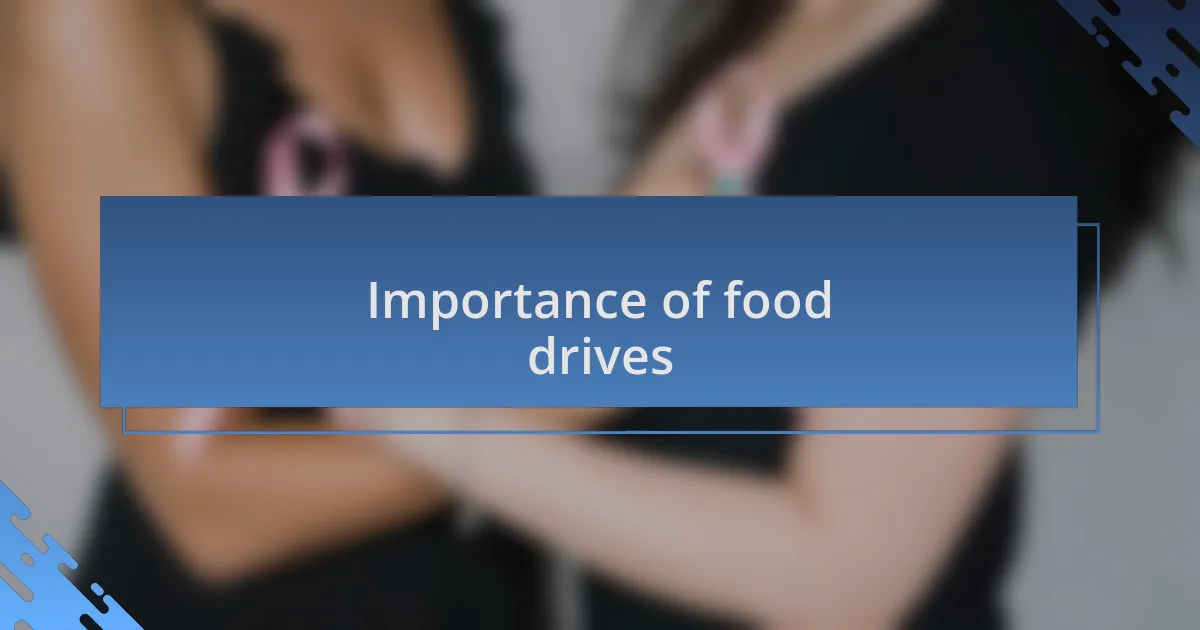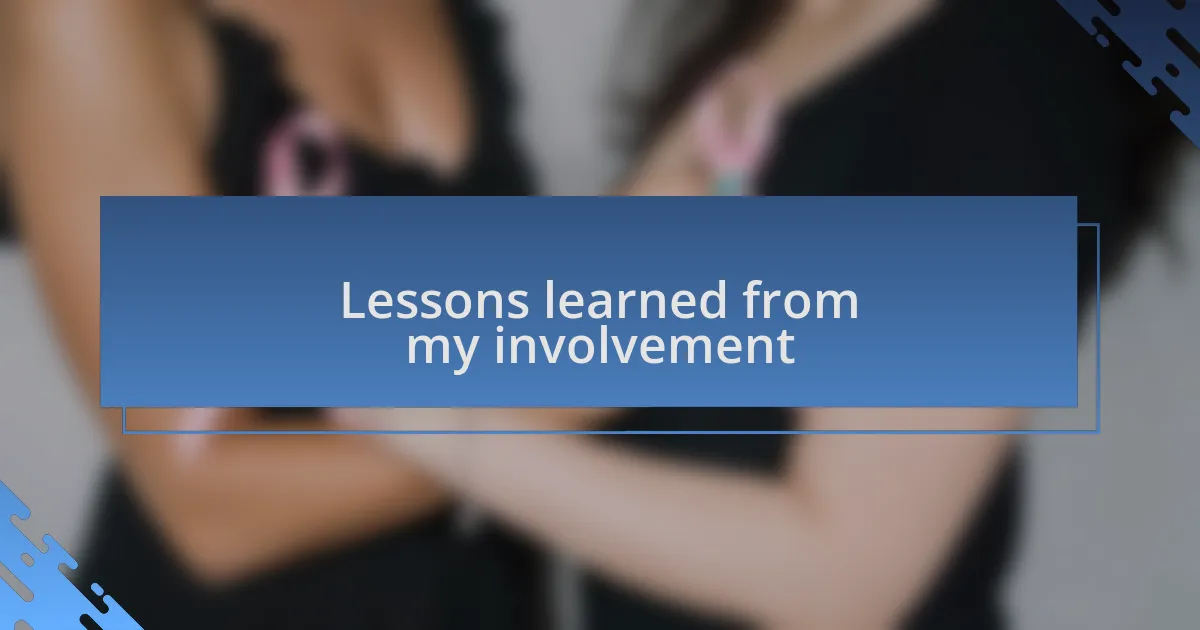Key takeaways:
- Charity efforts should focus on building connections and fostering dignity, recognizing the unique narratives of individuals experiencing homelessness.
- Food drives provide immediate relief and raise community awareness, but they also create opportunities for collaboration and future initiatives addressing root causes.
- Successful food drives require clear goals, strong teamwork, and flexibility to adapt to unforeseen challenges.
- Partnering with local organizations and businesses enhances the impact of food drives, fostering community unity and resource sharing.

Understanding homeless charity efforts
Understanding homeless charity efforts requires us to look beyond the immediate act of giving. I remember my first food drive; the atmosphere was electric, filled with excitement and a touch of nervousness. It struck me how a mere bag of groceries could carry so much weight, not just in terms of physical sustenance but also in the emotional lift it provided to those in need.
These efforts aren’t just about handing out food; they’re about building connections and fostering dignity. Have you ever thought about how a simple conversation can brighten someone’s day? One time, while volunteering, I shared a moment with a gentleman who just wanted to talk about his favorite family recipes. Hearing his stories reminded me that every person experiencing homelessness has a unique narrative, and recognizing that can transform the way we approach charity work.
Charity initiatives also play a critical role in community education and advocacy. I often reflect on an impactful workshop I attended, which focused on raising awareness about the systemic issues contributing to homelessness. It was an eye-opener, highlighting that our support should extend beyond food drives to include long-term solutions. What can we do, I wondered, to not only feed individuals but also empower them? That’s the kind of thinking that fuels effective charity work.

Importance of food drives
Food drives are essential because they provide immediate relief to those experiencing hunger, often serving as a lifeline for individuals and families in distress. I recall a particularly impactful drive where our team managed to collect surplus food from local markets. Watching families come forward to receive the items reminded me just how crucial these initiatives are; it’s not merely about filling stomachs but also restoring a sense of hope and normalcy.
Moreover, food drives can significantly raise community awareness about the ongoing struggles faced by marginalized populations. I’ve witnessed firsthand how local coverage of these events can spark conversations within neighborhoods. It got me thinking: how can a single food drive inspire others to take action? The answer lies in sharing these stories and fostering empathy, which can ultimately amplify the impact of collective community efforts.
Lastly, food drives foster collaboration among various organizations and individuals, creating a stronger support network for those experiencing homelessness. Participating in joint drives has allowed me to connect with passionate people who share a vision for change. Have you ever spoken to someone at one of these events and found unexpected common ground? Those connections not only enhance community resilience but also lay the groundwork for future initiatives that can address the root causes of food insecurity and homelessness.

Planning a successful food drive
Planning a successful food drive starts with setting clear goals and understanding the needs of your community. I once spearheaded a drive focused on specific nutritional needs, which encouraged donations that went beyond just canned goods. Have you ever considered how the right messaging can steer donations toward healthier options? It makes a significant difference.
Next, building a strong team is essential for effective execution. I remember teaming up with a local school, which not only boosted our volunteer numbers but also fostered a sense of shared purpose among students. Watching them mobilize their peers for the cause was incredibly inspiring—how can we ignite that same passion in our communities? Sparking that enthusiasm can lead to a more engaged and motivated group ready to tackle food scarcity.
Finally, logistics are the backbone of a successful drive. I learned this firsthand when our initial location fell through just days before the event. Thankfully, we quickly adapted by partnering with a local church, and the flexibility paid off. How prepared are we to pivot when things don’t go as planned? Having a backup plan can save a drive from faltering and ensure that the community still receives vital support.

Partnering with local organizations
Collaborating with local organizations can significantly enhance the impact of food drives. I found this out when I reached out to a nearby food bank for one of my initiatives, and they not only provided resources but also invaluable expertise. Have you ever thought about how much more effective a drive can be with seasoned partners guiding the process? It can completely change the game.
Local businesses can also play a pivotal role. I was surprised when a local grocery store agreed to feature our food drive flyers and donate a portion of their sales during the event. This partnership created a win-win situation and helped raise awareness within the community. Isn’t it amazing how businesses can rally around a cause and strengthen community ties?
Building relationships with community leaders can further amplify efforts. When I partnered with a local church, their congregation opened their doors and rallied a collective action spirit. It was heartwarming to see such diverse participation come together for a shared mission. How often do we tap into these networks to expand our reach? Engaging with local organizations can foster a sense of unity that truly embodies the spirit of giving.

Lessons learned from my involvement
One of the most profound lessons I’ve learned is the sheer strength of community. During a food drive, I witnessed how quickly people came together when they believed in a shared purpose. It made me realize that, at its core, helping the homeless isn’t just about food; it’s about creating a network of support that transcends individual efforts. Have you ever experienced that sense of collective accomplishment when people unite for a common cause?
Additionally, I discovered the importance of adaptability. In one drive, we had planned to collect canned goods, but a sudden storm created challenges for our collection points. Instead of getting discouraged, we pivoted, asking for non-perishable items that were easier to transport. This not only allowed us to meet our goals but also reinforced the idea that being flexible is essential in making a meaningful impact. How often do we overlook the power of adjusting our approach?
Finally, I’ve learned that sharing stories can be just as powerful as the act of giving itself. During a drive, I had the opportunity to speak with some of the beneficiaries. Hearing their experiences and struggles was incredibly moving, reminding me that every can or bag of food carries a deeper significance. Isn’t it fascinating how narratives can bridge gaps and foster understanding? This realization inspired me to ensure that every food drive isn’t just an event but a story worth telling.